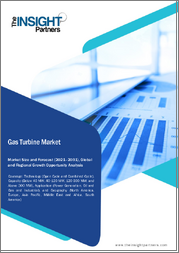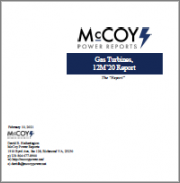
|
시장보고서
상품코드
1609791
일본의 가스터빈 시장 보고서 : 기술, 설계 유형, 정격 용량, 최종 사용자 및 지역별(2025-2033년)Japan Gas Turbine Market Report by Technology, Design Type (Heavy Duty Type, Aeroderivative Type), Rated Capacity, End User, and Region 2025-2033 |
||||||
일본 가스터빈 시장 규모는 2024년 16억 달러로 추정됩니다. IMARC Group은 2025년부터 2033년까지 5.2%의 연평균 성장률(CAGR)로 2033년에는 26억 달러에 달할 것으로 예측했습니다. 분산형 에너지 자원과 마이크로그리드 등 분산형 발전 추세가 강화되고 소형, 유연성이 높은 가스터빈에 대한 수요가 증가함에 따라 시장을 주도하고 있습니다.
본 보고서에서 다룬 주요 질문
- 일본의 가스터빈 시장은 지금까지 어떻게 발전해왔고 앞으로 어떻게 발전할 것인가?
- 코로나19가 일본 가스터빈 시장에 미치는 영향은?
- 일본 가스터빈 시장 기술별 분석은?
- 일본 가스터빈 시장의 설계 유형별 시장 현황은?
- 일본 가스터빈 시장의 정격용량별 시장 현황을 알려주세요.
- 일본 가스터빈 시장의 최종 사용자별 시장 현황은?
- 일본 가스터빈 시장의 밸류체인에는 어떤 단계가 있는가?
- 일본 가스터빈의 주요 추진 요인과 과제는?
- 일본 가스터빈 시장 구조와 주요 업체는?
- 일본 가스터빈 시장에서의 경쟁은 어느 정도인가?
목차
제1장 서문
제2장 조사 범위와 조사 방법
- 조사 목적
- 이해관계자
- 데이터 소스
- 시장 추정
- 조사 방법
제3장 주요 요약
제4장 일본의 가스터빈 시장 - 서론
- 개요
- 시장 역학
- 업계 동향
- 경쟁 정보
제5장 일본의 가스터빈 시장 구도
- 과거 및 현재 시장 동향(2019-2024년)
- 시장 예측(2025년-2033년)
제6장 일본의 가스터빈 시장 - 기술별 분석
- 복합 사이클 가스터빈
- 오픈 사이클 가스터빈
제7장 일본의 가스터빈 시장 - 설계 유형별 분석
- Heavy Duty (Frame) Type
- 항공기 전용형
제8장 일본의 가스터빈 시장 - 정격 용량별 분석
- 300MW 이상
- 120-300MW
- 40-120MW
- 40MW 미만
제9장 일본의 가스터빈 시장 - 최종사용자별 분석
- 발전
- 모빌리티
- 석유 및 가스
- 기타
제10장 일본의 가스터빈 시장 - 경쟁 구도
- 개요
- 시장 구조
- 시장 기업 포지셔닝
- 주요 성공 전략
- 경쟁 대시보드
- 기업 평가 상한
제11장 주요 기업 개요
제12장 일본의 가스터빈 시장 - 업계 분석
- 성장 촉진요인 및 억제요인과 기회
- Porter의 Five Forces 분석
- 밸류체인 분석
제13장 부록
LSH 24.12.23Japan gas turbine market size reached USD 1.6 Billion in 2024. Looking forward, IMARC Group expects the market to reach USD 2.6 Billion by 2033, exhibiting a growth rate (CAGR) of 5.2% during 2025-2033. The increasing trend toward decentralized power generation, including distributed energy resources and microgrids, which has enhanced the demand for smaller, more flexible gas turbines, is primarily driving the market.
A gas turbine, also known as a combustion turbine, is a type of internal combustion engine that converts chemical energy from fuel into mechanical energy through the process of combustion. It operates on the principle of the Brayton cycle, which consists of four key stages: air intake, compression, combustion, and exhaust. In a gas turbine, ambient air is drawn into the engine and compressed, increasing its pressure and temperature. This high-pressure air is then mixed with fuel and ignited, creating a high-velocity stream of hot gases. These gases expand through a series of turbines, which are connected to a shaft that drives various mechanical devices, such as aircraft propellers, electricity generators, or industrial machinery. As the gas flows through the turbines, it loses energy, generating useful mechanical work. Gas turbines are renowned for their efficiency, power-to-weight ratio, and versatility. They are widely used in aviation for propulsion, electricity generation in power plants, and even as mechanical drivers in various industrial applications, owing to their ability to deliver high power output with relatively low emissions.
Japan Gas Turbine Market Trends:
The gas turbine market in Japan is experiencing robust growth due to several key drivers. Firstly, the increasing regional demand for electricity continues to be a major catalyst. As populations grow and industries expand, the need for reliable and efficient power generation becomes paramount. Additionally, the shift towards cleaner energy sources has propelled the gas turbine market forward. Governments and organizations in Japan are prioritizing cleaner energy solutions to combat environmental challenges, making gas turbines an attractive choice for their lower emissions and fuel efficiency. Furthermore, the aerospace industry's growth has significantly contributed to the gas turbine market's expansion. The demand for more fuel-efficient and environmentally friendly aircraft engines has spurred innovation in gas turbine technology. Moreover, the rise of distributed power generation and the need for quick-start, grid-balancing solutions have boosted the market. Gas turbines' ability to rapidly respond to fluctuating power demands aligns with the evolving energy landscape. In conclusion, the gas turbine market's growth is expected to be driven by the rising demand for electricity, the push for cleaner energy sources, the aerospace industry's advancements, and the increasing need for flexible power generation solutions.
Japan Gas Turbine Market Segmentation:
Technology Insights:
- Combined Cycle Gas Turbine
- Open Cycle Gas Turbine
Design Type Insights:
- Heavy Duty (Frame) Type
- Aeroderivative Type
Rated Capacity Insights:
- Above 300 MW
- 120-300 MW
- 40-120 MW
- Less Than 40 MW
End User Insights:
- Power Generation
- Mobility
- Oil and Gas
- Others
Competitive Landscape:
The market research report has also provided a comprehensive analysis of the competitive landscape. Competitive analysis such as market structure, key player positioning, top winning strategies, competitive dashboard, and company evaluation quadrant has been covered in the report. Also, detailed profiles of all major companies have been provided.
Key Questions Answered in This Report:
- How has the Japan gas turbine market performed so far and how will it perform in the coming years?
- What has been the impact of COVID-19 on the Japan gas turbine market?
- What is the breakup of the Japan gas turbine market on the basis of technology?
- What is the breakup of the Japan gas turbine market on the basis of design type?
- What is the breakup of the Japan gas turbine market on the basis of rated capacity?
- What is the breakup of the Japan gas turbine market on the basis of end user?
- What are the various stages in the value chain of the Japan gas turbine market?
- What are the key driving factors and challenges in the Japan gas turbine?
- What is the structure of the Japan gas turbine market and who are the key players?
- What is the degree of competition in the Japan gas turbine market?
Table of Contents
1 Preface
2 Scope and Methodology
- 2.1 Objectives of the Study
- 2.2 Stakeholders
- 2.3 Data Sources
- 2.3.1 Primary Sources
- 2.3.2 Secondary Sources
- 2.4 Market Estimation
- 2.4.1 Bottom-Up Approach
- 2.4.2 Top-Down Approach
- 2.5 Forecasting Methodology
3 Executive Summary
4 Japan Gas Turbine Market - Introduction
- 4.1 Overview
- 4.2 Market Dynamics
- 4.3 Industry Trends
- 4.4 Competitive Intelligence
5 Japan Gas Turbine Market Landscape
- 5.1 Historical and Current Market Trends (2019-2024)
- 5.2 Market Forecast (2025-2033)
6 Japan Gas Turbine Market - Breakup by Technology
- 6.1 Combined Cycle Gas Turbine
- 6.1.1 Overview
- 6.1.2 Historical and Current Market Trends (2019-2024)
- 6.1.3 Market Forecast (2025-2033)
- 6.2 Open Cycle Gas Turbine
- 6.2.1 Overview
- 6.2.2 Historical and Current Market Trends (2019-2024)
- 6.2.3 Market Forecast (2025-2033)
7 Japan Gas Turbine Market - Breakup by Design Type
- 7.1 Heavy Duty (Frame) Type
- 7.1.1 Overview
- 7.1.2 Historical and Current Market Trends (2019-2024)
- 7.1.3 Market Forecast (2025-2033)
- 7.2 Aeroderivative Type
- 7.2.1 Overview
- 7.2.2 Historical and Current Market Trends (2019-2024)
- 7.2.3 Market Forecast (2025-2033)
8 Japan Gas Turbine Market - Breakup by Rated Capacity
- 8.1 Above 300 MW
- 8.1.1 Overview
- 8.1.2 Historical and Current Market Trends (2019-2024)
- 8.1.3 Market Forecast (2025-2033)
- 8.2 120-300 MW
- 8.2.1 Overview
- 8.2.2 Historical and Current Market Trends (2019-2024)
- 8.2.3 Market Forecast (2025-2033)
- 8.3 40-120 MW
- 8.3.1 Overview
- 8.3.2 Historical and Current Market Trends (2019-2024)
- 8.3.3 Market Forecast (2025-2033)
- 8.4 Less Than 40 MW
- 8.4.1 Overview
- 8.4.2 Historical and Current Market Trends (2019-2024)
- 8.4.3 Market Forecast (2025-2033)
9 Japan Gas Turbine Market - Breakup by End User
- 9.1 Power Generation
- 9.1.1 Overview
- 9.1.2 Historical and Current Market Trends (2019-2024)
- 9.1.3 Market Forecast (2025-2033)
- 9.2 Mobility
- 9.2.1 Overview
- 9.2.2 Historical and Current Market Trends (2019-2024)
- 9.2.3 Market Forecast (2025-2033)
- 9.3 Oil and Gas
- 9.3.1 Overview
- 9.3.2 Historical and Current Market Trends (2019-2024)
- 9.3.3 Market Forecast (2025-2033)
- 9.4 Others
- 9.4.1 Historical and Current Market Trends (2019-2024)
- 9.4.2 Market Forecast (2025-2033)
10 Japan Gas Turbine Market - Competitive Landscape
- 10.1 Overview
- 10.2 Market Structure
- 10.3 Market Player Positioning
- 10.4 Top Winning Strategies
- 10.5 Competitive Dashboard
- 10.6 Company Evaluation Quadrant
11 Profiles of Key Players
- 11.1 Company A
- 11.1.1 Business Overview
- 11.1.2 Product Portfolio
- 11.1.3 Business Strategies
- 11.1.4 SWOT Analysis
- 11.1.5 Major News and Events
- 11.2 Company B
- 11.2.1 Business Overview
- 11.2.2 Product Portfolio
- 11.2.3 Business Strategies
- 11.2.4 SWOT Analysis
- 11.2.5 Major News and Events
- 11.3 Company C
- 11.3.1 Business Overview
- 11.3.2 Product Portfolio
- 11.3.3 Business Strategies
- 11.3.4 SWOT Analysis
- 11.3.5 Major News and Events
- 11.4 Company D
- 11.4.1 Business Overview
- 11.4.2 Product Portfolio
- 11.4.3 Business Strategies
- 11.4.4 SWOT Analysis
- 11.4.5 Major News and Events
- 11.5 Company E
- 11.5.1 Business Overview
- 11.5.2 Product Portfolio
- 11.5.3 Business Strategies
- 11.5.4 SWOT Analysis
- 11.5.5 Major News and Events
12 Japan Gas Turbine Market - Industry Analysis
- 12.1 Drivers, Restraints, and Opportunities
- 12.1.1 Overview
- 12.1.2 Drivers
- 12.1.3 Restraints
- 12.1.4 Opportunities
- 12.2 Porters Five Forces Analysis
- 12.2.1 Overview
- 12.2.2 Bargaining Power of Buyers
- 12.2.3 Bargaining Power of Suppliers
- 12.2.4 Degree of Competition
- 12.2.5 Threat of New Entrants
- 12.2.6 Threat of Substitutes
- 12.3 Value Chain Analysis




















